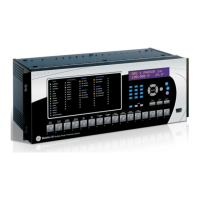CHAPTER 5: SETTINGS CONTROL ELEMENTS
F35 MULTIPLE FEEDER PROTECTION SYSTEM – INSTRUCTION MANUAL 5-301
5
The thermal overload protection element estimates accumulated thermal energy E using the following equations
calculated each power cycle. When current is greater than the pickup level, I
n
> k × I
B
, element starts increasing the
thermal energy:
Eq. 5-26
When current is less than the dropout level, I
n
> 0.97 × k × I
B
, the element starts decreasing the thermal energy:
Eq. 5-27
where
∆t is the power cycle duration
n is the power cycle index
t
op(In)
is the trip time calculated at index n as per the IEC255-8 cold curve or hot curve equations
t
rst(In)
is the reset time calculated at index n as per the reset time equation
I
n
is the measured overload RMS current at index n
E
n
is the accumulated energy at index n
E
n–1
is the accumulated energy at index n – 1
The thermal overload protection element removes the
THERMAL PROT 1 OP output operand when E < 0.05. In case of
emergency, the thermal memory and
THERMAL PROT 1 OP output operand can be reset using THERM PROT 1 RESET setting.
All calculations are performed per phase. If the accumulated energy reaches value 1 in any phase, the thermal overload
protection element operates and only resets when energy is less than 0.05 in all three phases.
Table 5-34: Typical time constants
The figure shows the logic for the thermal overload protection element.
Protected equipment Time constant Minimum reset time
Capacitor bank 10 minutes 30 minutes
Overhead line 10 minutes 20 minutes
Air-core reactor 40 minutes 30 minutes
Busbar 60 minutes 20 minutes
Underground cable 20 to 60 minutes 60 minutes

